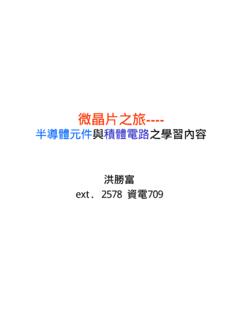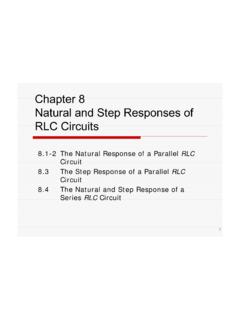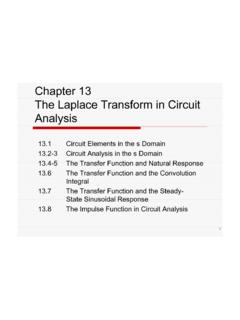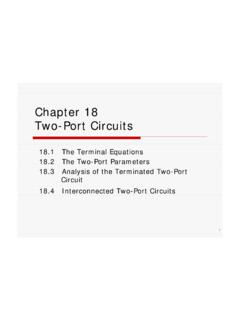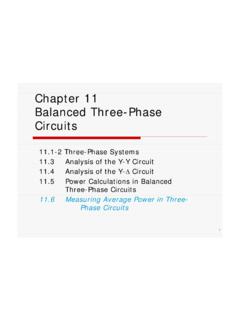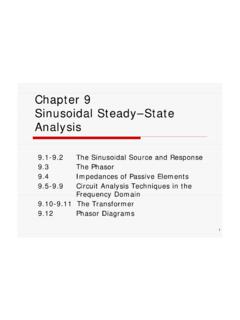Transcription of 電力電子元件簡介 - ee.nthu.edu.tw
1 Page 1 Introduction to Power Electronic DevicesC. M. LiawDepartment of Electrical EngineeringNational Tsing Hua UniversityHsinchu, Taiwan, ROC. ( Power diode) ( SCR)SCRP ower diodeFiring circuitPLoadLoadDiode: Uncontrolled turn-on andturn-off AC sourceAC source SCR: Controlled turn-on and uncontrolled turn-off Page 2 ( )Voltage/current ratingsSwitching frequency (speed)Switching timeOn-state resistance (or on-state voltage/current) (A) (Thyristor) (Silicon ControlledRectifier, SCR) : Controlled turn-on, uncontrolled turn-off(B) (Bidirectional Thyristor TRIAC) (E) (Power BJT) : Current control device (H) (Power MOSFET) : Voltage control device(F) IGBT (Insulated Gate Bipolar Transistor):-Combines the conduction characteristic of BJT and the control characteristic of the MOSFET(C) GTO (Gate Turn-off Thysistor)(G) MOS (MOS -controlled Thyristor, MCT).
2 -Combines the load characteristic of the thyristorand the control characteristic of the MOSFET-Low on-state voltage (I) (D) (Integrated Gate-Commutated Thyristor, IGCT):It is introduced by ABB in 1997. It is a high-voltage, hard-driven, asymmetrical-blocking GTO with unity gain. The gate drive circuit is built-in on the device module. Page 3 (1) Uncontrolled turn-on and off: (diode)(2) Controlled turn-on and uncontrolled turn-off: (SCR)(3) Controlled turn-on and off (Controllable switches):(GTO, IGCT, MCT, BJT, IGBT, MOSFET)(4)Continuous gate signal requirement:(IGCT, BJT, IGBT, MOSFET)(5)Pulse gate signal requirement:(MCT, SCR, TRIAC, GTO)(6) Bipolar voltage-withstanding capability: (SCR)(7)Unipolarvoltage-withstanding capability: (GTO, IGCT, MCT, BJT, IGBT, MOSFET)(8) Bidirectional current capability:(TRIAC)(9)Unidirectional current capability.
3 (SCR, GTO, IGCT, MCT,BJT, IGBT, MOSFET, diode)Classification of state-of-the-art Power Semi-conductorsSiCPower SemiconductorsPage 4 InputfilterPowerConverterOutputfilterSwi tchingControl SignalGeneratorPowersource(AC, DC)Output source(to load) (Cycloconverter)( ) (Converter): Phase control, integral cycle control (Inverter): VVVF, VVFF (Chopper): PWM control, FM control : :( )( )( )( / ) Feedback Command Loads:Power suppliesMotor drives Page 5 ? ?(1) (2) (3) (4) (5) ( ) (6) (7) (8) (9) ( ) Power diodes: General purpose (for high-power rectification)High speed (for switching application)Schottky(for extra-low voltage rectification)ThyristorsPower transistorsPage 6 SCR ( ) (Thyristor)- (Silicon Controlled Rectifier, SCR) : Controlled turn-on, uncontrolled turn-offConstruction, symbol, equivalent circuit, triggering control,v-i characteristics: Q1 PNPNPNPNNPQ2cbii21=cbii12=AGKAAGGKKGAKTw o-transistor modelPage 7iiiGGG123>>AKiAKv)(RWMRBVVHI)(BOFBVVSCR PNPNAGK-+RBRBFB0 AKiBreakdown )(fi>RWMRBAKVV viiiGGG123>>AKiAKv)(RWMRBVVHI)(BOFBVVSCR .
4 AK-+AKiGKiPNPNGRBFBFBPage 8 Two-transistor modelQ1Q2cbii21=cbii12=AGKamplified)ly cumulative is(Current fifififiiiiicbcbNormally triggered: GSi>0 AKv>0 Abnormally triggered:High dv/dtHigh temperatureFBAKVv> Turn on:GSi>0 AKv>0 Turn off:)currentHolding(IiHAK< FBVRBViiiGGG123>>AKiAKv)(RWMRBVVHI)(BOFBVVPage 9 Gate SCR (Shockley diode)fivVONiIOFFAKFBAKH fi<fi,AK on off:Triac(AC Thyristor)A three-terminal, five layer, bilateral semiconductor TRIodeACthyristor. T2T1 GTab electricallyconnected to T2 TRIACPage 10+-+-IT48 THT1T2 GPower supplyTRIACT riac 2T1TG2N1N2P3N4N1 PTRIACA three-terminal, five layer, bilateral semiconductor :TT--- 322121 NPNP:TT--- Page 11 TRIAC: SCR bidirectional current capability Turn on:0>iGK AKv>0 Turn off:AKiIHoldingcurrentH<()0<iGK AKv<0)A(T1)K(T2 GfiGT2T1iiiGGG123>>AKi12 TTv-RBVFBVHIT2T1 GiGvvTTT=-21+-iiTTT=-21)(AKvTypical Applications of SCR and TRIACnConverter power control(1) Phase control(2) Integral cycle control nSSR (Solid State Relay) or AC SwitchPage 12 (Controllable Switches) (1) Forced-commutated SCR(2) BJT, MOSFET, IGBT, MCT.
5 +-iTvTControlsignalpT=iTvT : :(1) Off : Leakage current(2) On : , RON VONONRONVC onduction loss tiTvTONViTturn-onturn-off(Switching losses)Switching speed Switching losses pT=iTvT Power BJTBCEBICIC urrent-controlled deviceTurn on: minsat,CB/IIb Page 13 Power BJT,BVSUSV oltage ratings: (primary breakdown)circuited)open is (E max,VCBcircuited)open is (B max,VCE0 CmaxCEIwhen,V,BVCEOCBOBVS econdary breakdown:Caused by large di/dtat turn-on instant. CiPower BJTHard saturationand quasi-saturation:CEvBIminsat,CB/IIb=mins at,CB/IIb>Quasi-saturation:Hard-saturati on:Conduction loss Switching speed is smaller compared with small-signal BJTs. bPage 14vthGS,Power MOSFETV oltage-controlled deviceTurn on: GSDGS vsmall)(very 0, >-ivvstatesteady,GthGSGSP arasitic C GSv =fi swGSggGSfvQP v :dominant loss SwitchingnLight load:Power MOSFETDSvonR/11 GSvDi1GS2 GSvv>1Di1D2 Dii>vvvth,GSGSmax,GS>> fi switchingonsat,DGSP ,R ,i v fi R v :dominant loss onductionCon,DSGSnHeavy load:charge gate totalQg= ~ ,DSBVkR=Page 15 Cool MOSFETIt is a new revolutionary technology for high voltage power MOSFETs.
6 It implements a compensation structure in the vertical drift region of a MOSFET in order to improve the on-state is rating current Pulse10%)(~ higher slightly ,Q ,R JAgon,DSq Page 16 Page 17 Page 18 Page 19 Page 20 Power MOSFET Power BJT Power MOSFET(Enhancement mode)Power BJTONRONVGSDBCE+-GSv Turn on: GSGSthGsteadystatevviverysmall> -,,,() 0 : Thermal run away switching speedBICI : MOSFET Thermal run away ONONRV,0=ONsatCEONRVV,,={{ Turn on: BCsatII>,min/b switching speed MOSFET , {{Page 21 IGBT (Insulated Gate Bipolar Transistor):-Combines the conduction characteristic of BJT and the control characteristic of the MOSFET Symbol and equivalent circuit:GE(S)C(D)GC(D)E(S)GC(D)E(S)GC(D) E(S)IGBT (Insulated-Gate Bipolar Transistor)MOSTFET + BJTGC(D)E(S)Damping filterPrinted circuitboard vGSPage 22 MCT (MOS-controlled Thyristor)MOSTFET + ThyristorCombines the load characteristic of thyristorand the control characteristic of MOSFETLow on-state voltageSymbolK (Cathode)GA(Anode)Turn on: VGA p-ch MOSFET M1 BJT Q2 MCT on Turn off: VGA n-ch MOSFET M2 BJT Q1 MCT +-ThyristorGPage 23 Triggering Devices ( )n (Shockley diode), Four-layer diodenDIACnUJT (Uni-junction Transistor)nPUT (Programmable Uni-junction Transistor)nSUS (Silicon Unilateral Switch)nSBS (Silicon Unilateral Switch)n Gate SCRfivVONiIOFFAKFBAKH fi<fi,AK on off: (Shockley diode)Page 24vvVONiIOFFAKAKFBAKH> fi<fi0:, vvVONiIOFFAKAKRBAKH< fi<fi0.}}}}
7 ,T1T2 DIAC ( Gate TRIAC)on off:AKiAKvRBVFBVHIHIB2electricallyconnec ted to caseB2B1 ETO-18 package (Uni-Junction Transistor, UJTUJT)B1B2 EnpB2B1 ErB1rB2 VDIEVEB+-Page 25 Emitter Characteristic CurveB2B1 EEIEBV+-IVVPImAE()VVEB()VVPV-+BBVEBEVI voltagePeak VVrrrVVVpDBBBBBDBB=++=+1122121,,Dhratio standoff Intrinsic 211(:rrrBBB+=Dh, )R1B2B1EC1R2R3+-VBBT2T1G+-Vo2+-VC1VC1 VPVVt2oVTRC 11tApplication: Relaxation OSC. (Relaxation OSC. ( ))1oV1oVTRC 11tPositive going pulsePage 26 Programmable UnijunctionTransistor, PJTPJT)GnPNPNAKGAKQ1Q2 AKGBBDBBDpVVVRRRVVh+=++=D323 hGAKT2T1GR1C1R24R+-VBB2oV3oV3 RBBDBBDpVVVRRRVVh+=++=D3231oVPage 27 SiC(Silicon Carbide) Power DevicesPage 28 Introduction to Introduction to SiCSiCSilicon Carbide (SiC) is a wide-bandgap semiconductor, which has been intensively studied in therecent years, due to its physical properties, such as high breakdown field, high saturated drift velocity and high thermal conductivity.
8 This characteristics make SiCa very good candidate for the applicationsin which high temperature, high radiation intensity, high voltage or highpower dissipation are involved, such as temperature sensors, nuclear radiation detectors, UV detectors, microwave devices and power devices. Although of the high potential of this material for the use in the electronic industry, the SiCtechnology shows some limitations and requires further study in order to obtain electronic devices of the same quality standards as Sitechnology: the bulk growth of SiCis still very expensive and material quality is still lower than device production requirements; the epitaxialgrowthis necessary to obtain device-quality material, but it requires high temperature processes; selective doping of SiClayers requires the use of ion implantation, since the diffusion coefficients for the doping species are too small for practical applications; the realization of ohmiccontacts on SiCis difficult and requires high temperature processes.
9 The thermal oxidation of SiCis difficult due to the high temperature needed and the qualityof the material obtained is still lower respect to limitations underline the need of further study in the SiCfield. In particular, the growth of epitaxiallayers is a first-step process for the realization of a wide variety of electronicdevices.


